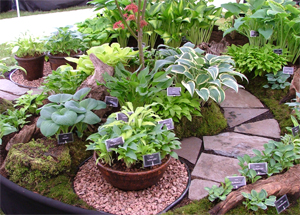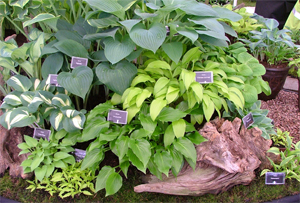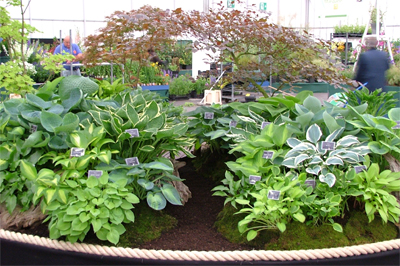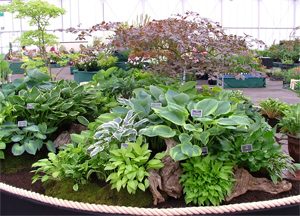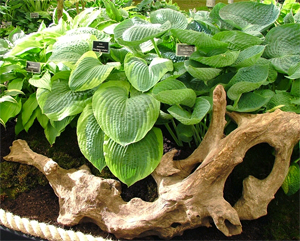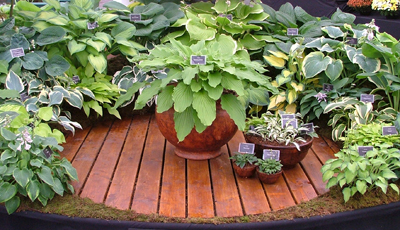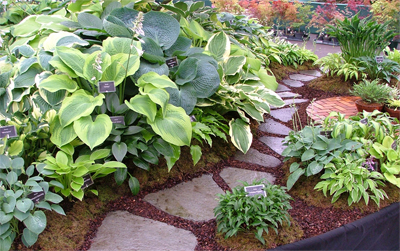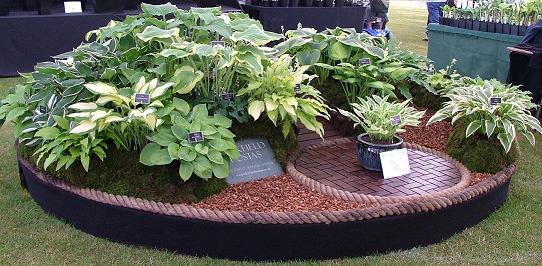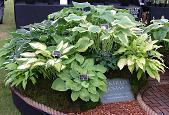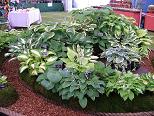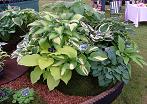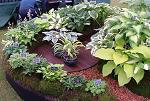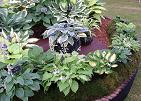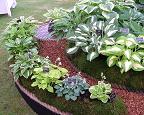
| Inspiring spaces Our recent endeavours at producing displays at flower shows have resulted in some excellent feedback from garden designers, together with Gold and Premier medals and trophies. The only problem is these displays are temporary, so the ideas are lost at the end of the show. Therefore, we have created this section of the website to share some of the most successful planting concepts and give you some ideas of how to adapt them to your own garden. We are also begining to landscape some spaces at the nursery, such as our 'Rubber Rockery' using old tyres, and plans to create an arboretum and hosta garden - find out more here Breaking up areas into smaller planting plots Sometimes features already exist in established gardens, which can help stimulate ideas on further planting. However, many gardens are blank canvasses, often flat and featureless, especially within newly built estates. This is what we start with at every show, a blank, flat and featureless expanse of board! We have to think about using props, both natural and man-made, to create structure and form but on the right sort of scale. We often use immature trees to help us achieve height but this can also be done using pergolas and shaped trellis. In our 2012 Malvern Spring Flower Show display we created two separate planting areas with a slate path winding between the two. Each end of the path had shingle areas used to display potted hostas. Bog oak was used to create the illusion of roots from pre-existing trees, as if the garden had been created in an area of recovered forest (click on images ot view larger):
Height & structure Using trees is a great way to add form and structure to a planting scheme and anyone seeing us at shows over the past 10 years might have seen one of our star features - our copper beech. Time and again we have used this lovely chance find because of its architectural form and fantastic leaf colour. We particularly like to use the shape to pull display elements together and help lead the eye from one part of the stand to another. The photographs below show the beech doing just this at Gardeners' World Live in 2012. The exhibit was being considered for the 'best in show' award because the judges were so impressed with the design of the stand. This was particularly gratifying due to the effort taken to put it together. It was 17' in diameter, which is a big space to fill. However, it did give us plenty of space to experiment with lots of different sized hostas, in different growing conditions:
If you click on the left-hand image you will see how effective it can be to plant giant and small varieties together rather than sticking to plants of a similar stature. It is a great trick in smaller spaces and is something you could scale up or down depending upon the space you have.
Working with existing features
What we were trying to achieve was to highlight how you can tackle a large area of garden and divide it into areas to plant separately. It is quite a daunting task to set about landscaping a large area in one go, breaking it up into different areas not only helps you to tackle the job a bit at a time, it can also stimulate ideas, which can evolve as you go.
So don't let a lack of space thwart plans you may have, it is quite possible to create something interesting in quite a small area. In 2014, we decided to refine the idea of creating a spiral garden in a 12' diameter circle. The idea was to show how you can create something that takes you on a journey round the space. We found customers moving round the stand as their eyes followed the design. We created two main spiral paths, linked by two decks and the wooden bridge. We then selected plants that would add definition to the spaces in between. The idea was simple and very effective. By Hampton Court Flower Show we had perfected the design but our favourite photos were of our display at the Royal Norfolk, immediately before Hampton Court - click on the images to view larger: |

